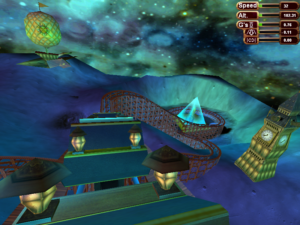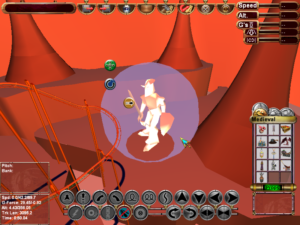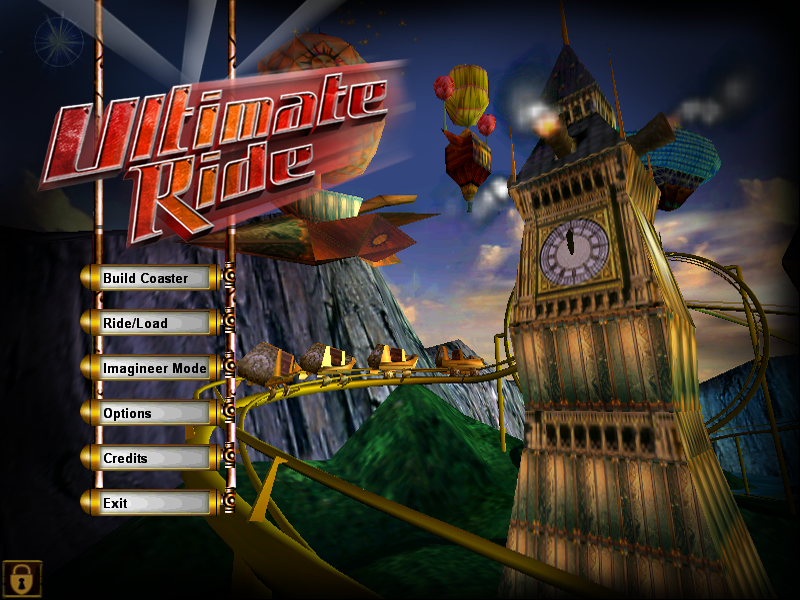Ultimate Ride 
Out of all the games published by Disney, Ultimate Ride is the only one credited to Disney Imagineering – the legendary, secretive R&D division of the company’s theme parks.
Granted, Imagineering has designed their share of interactive experiences, notably the defunct, hyper-stylized digital indoor theme park concept DisneyQuest. And they didn’t actually develop Ultimate Ride themselves, besides giving their “support and guidance,” according to the credits. But if they felt comfortable putting the Disney Imagineering brand name on a video game, that reads like an endorsement. That makes Ultimate Ride even more interesting, because it’s a game where, like Imagineering, you design your own theme park rides.
Ultimate Ride landed at a moment when the theme park game genre was having a spike in popularity. Maybe it’s because graphics for home computers and game consoles had reached the point where they could render a roller coaster ride in 3D with some level of smoothness and graphical fidelity, but the late 90s and early 2000s saw a flurry of theme park games hitting the market, like Roller Coaster Tycoon; Coaster Works; the first installment in the NoLimits series; the next installments in the Theme Park series; and a bunch of budget-priced imitations. Disney had some experience with this genre, having previously published a game that was simply called Coaster back in 1993, so perhaps it made sense for one of the biggest names in theme parks to get in on the action again too.

Ultimate Ride skips the theme park and lets you build roller coasters in fantasy landscapes, like this trippy asteroid
In most ways, it’s like the other roller coaster games from this period. You can build some gnarly roller coasters, and thanks to some abusable quirks in the physics engine, you can make a ride that goes magnitudes faster than the speed of sound and exerts the g-force equivalent of slamming a 747 into a brick wall. In other words, it’s great. The development team at Gigawatt Studios – which, not coincidentally, had also worked on an attraction at DisneyQuest1 – put together a powerful, easy-to-use toolkit that compares well with the other titles that were on the market.
It’s a good roller coaster game, but what about Ultimate Ride warranted a rare endorsement from Disney Imagineering? For one thing, there’s an Imagineering Mode, which teaches you about the principles of good ride design through a series of challenges, like finishing an incomplete coaster while limiting the g-forces. That’s certainly part of it, and while Disney Imagineering does have to think about those type of real-life design challenges, their theme parks aren’t exactly known for face-melting roller coasters.
If there’s one thing Imagineering is known for, it’s theming.
If people just want to ride a roller coaster, they can go to Six Flags. What distinguishes a massive, expensive theme park like Disney’s is the element they refer to internally as “show” – the presentation, story, and character that encourages you to suspend your disbelief, that turns an attraction into a full-fledged experience. That’s where Disney’s money and attention goes. Whether or not this is just PR fluff, if you watch any of the behind-the-scenes documentaries about Imagineering, they always come back to the notion that rides are telling stories.

Decorations are an important piece of the ride design, as evidenced by the fine control you have over them
While Ultimate Ride doesn’t go that far – you’re certainly not telling stories with it – it does give you a handful of options for theming your ride. The game leaves behind the typical amusement park setting and takes you somewhere magical instead, like deep inside a lava-filled cavern, and encourages you to fill it up with decorations. There’s always a prominent window on-screen where you can pick out props from three different themes: Medieval, Outer Space, and something new-age steampunk-y called “Crystal Empire.” These are huge, imaginative objects, so you’re not just adoring your roller coaster with trees, but with things like dragons, airships, floating video screens, and volcanoes, objects that fill your view and totally change the tone of the ride.
Although it’s not required to add any props to your roller coaster, Ultimate Ride seems to strongly encourage it. It’s not much, but it’ll get you thinking about how you can put more “show” in your attractions. Why just put a crystal pyramid in the background when you could make it the focal point of the ride instead?
It’s still only a minor part of the game, relative to everything else. If you look back at the magazine ads for Ultimate Ride, they’re all about building crazy-ass roller coasters, not decorating them.2,3,4 (My favorite is the ad featuring a dude bragging about his ultra-dangerous abomination of a coaster called “Nurse Wacko’s Scalpel” that pulls more g-force than any currently standing roller coaster. “Is it sick and twisted or twisted and sick?” he asks, for he does not know.4) Designing a gut-churning, physics-breaking roller coaster is the main draw, and for good reason.
But compared to the other roller coaster games coming out during this mini-renaissance for the theme park genre, the high-key placement given to the game’s limited set of decorations is noticeable. Future versions of Ultimate Ride would expand on the theming aspects with more props and, eventually, more Disney brand-friendly settings. It’s a small difference, and maybe that’s why Imagineering put their name on it.
A note on compatibility
Ultimate Ride mostly runs fine on Windows 10, as long as you run it in compatibility mode for Windows XP. The one major issue – which might be a deal-breaker – is that the game crashes when you’re trying to save your roller coaster. This is a big limitation, but you can still design rides and play the Imagineering challenge mode.
References
1. Tetterton, Quinn. (n.d.). “Quinn Tetterton – Digital Consultant – Creative Producer.” p. 5. Retrieved from http://www.mrtetterton.com/T_resume.pdf
2. Disney Interactive. (2001, Dec.). Ultimate Ride [Advertisement]. PC Gamer, 8(9), p.58-59. Retrieved from https://archive.org/details/pcgamer200112/page/n61/
3. Disney Interactive. (2001, Nov.). Ultimate Ride [Advertisement]. NextGen, 3(11), p.4-5. Retrieved from https://archive.org/details/NextGen83Nov2001/page/n5/
4. Disney Interactive. (2001, Oct.). Ultimate Ride [Advertisement]. NextGen, 3(10), p.2-3. Retrieved from https://archive.org/details/NextGen82Oct2001/page/n3/


i remember this (and i immediately recognized the coaster car with lanterns on it as i was scrolling through your simulation archives). i had to re-make “the mad flying duck” numerous times because the save files would sometimes become corrupted or something. Frame rate wasn’t always the best on my computer, either!
Had to check: looks like Disney’s Atlantis came out just a few months before this did.